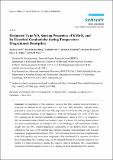| dc.contributor.author | Groß, Andrea | |
| dc.contributor.author | Kremling, Michael | |
| dc.contributor.author | Marr, Isabella | |
| dc.contributor.author | Kubinski, David | |
| dc.contributor.author | Visser, Jacobus | |
| dc.contributor.author | Moos, Ralf | |
| dc.contributor.author | Tuller, Harry L. | |
| dc.date.accessioned | 2014-12-11T19:14:47Z | |
| dc.date.available | 2014-12-11T19:14:47Z | |
| dc.date.issued | 2013-04 | |
| dc.date.submitted | 2013-03 | |
| dc.identifier.issn | 1424-8220 | |
| dc.identifier.uri | http://hdl.handle.net/1721.1/92286 | |
| dc.description.abstract | An impedimetric NO[subscript x] dosimeter based on the NO[subscript x] sorption material KMnO[subscript 4] is proposed. In addition to its application as a low level NO[subscript x] dosimeter, KMnO[subscript 4] shows potential as a precious metal free lean NO[subscript x] trap material (LNT) for NO[subscript x] storage catalysts (NSC) enabling electrical in-situ diagnostics. With this dosimeter, low levels of NO and NO[subscript 2] exposure can be detected electrically as instantaneous values at 380 °C by progressive NO[subscript x] accumulation in the KMnO[subscript 4] based sensitive layer. The linear NO[subscript x] sensing characteristics are recovered periodically by heating to 650 °C or switching to rich atmospheres. Further insight into the NO[subscript x] sorption-dependent conductivity of the KMnO[subscript 4]-based material is obtained by the novel eTPD method that combines electrical characterization with classical temperature programmed desorption (TPD). The NO[subscript x] loading amount increases proportionally to the NO[subscript x] exposure time at sorption temperature. The cumulated NO[subscript x] exposure, as well as the corresponding NO[subscript x] loading state, can be detected linearly by electrical means in two modes: (1) time-continuously during the sorption interval including NO[subscript x] concentration information from the signal derivative or (2) during the short-term thermal NO[subscript x] release. | en_US |
| dc.description.sponsorship | National Science Foundation (U.S.). Division of Materials Research (Material World Network DMR-0908627) | en_US |
| dc.language.iso | en_US | |
| dc.publisher | MDPI AG | en_US |
| dc.relation.isversionof | http://dx.doi.org/10.3390/s130404428 | en_US |
| dc.rights | Creative Commons Attribution | en_US |
| dc.rights.uri | http://creativecommons.org/licenses/by/3.0/ | en_US |
| dc.source | Sensors | en_US |
| dc.title | Dosimeter-Type NO[subscript x] Sensing Properties of KMnO[subscript 4] and Its Electrical Conductivity during Temperature Programmed Desorption | en_US |
| dc.type | Article | en_US |
| dc.identifier.citation | Groß, Andrea, Michael Kremling, Isabella Marr, David Kubinski, Jacobus Visser, Harry Tuller, and Ralf Moos. “Dosimeter-Type NO[subscript x] Sensing Properties of KMnO[subscript 4] and Its Electrical Conductivity During Temperature Programmed Desorption.” Sensors 13, no. 4 (April 2013): 4428–4449. | en_US |
| dc.contributor.department | Massachusetts Institute of Technology. Department of Materials Science and Engineering | en_US |
| dc.contributor.mitauthor | Tuller, Harry L. | en_US |
| dc.relation.journal | Sensors | en_US |
| dc.eprint.version | Final published version | en_US |
| dc.type.uri | http://purl.org/eprint/type/JournalArticle | en_US |
| eprint.status | http://purl.org/eprint/status/PeerReviewed | en_US |
| dspace.orderedauthors | Groß, Andrea; Kremling, Michael; Marr, Isabella; Kubinski, David; Visser, Jacobus; Tuller, Harry; Moos, Ralf | en_US |
| dc.identifier.orcid | https://orcid.org/0000-0001-8339-3222 | |
| mit.license | PUBLISHER_CC | en_US |
| mit.metadata.status | Complete | |
